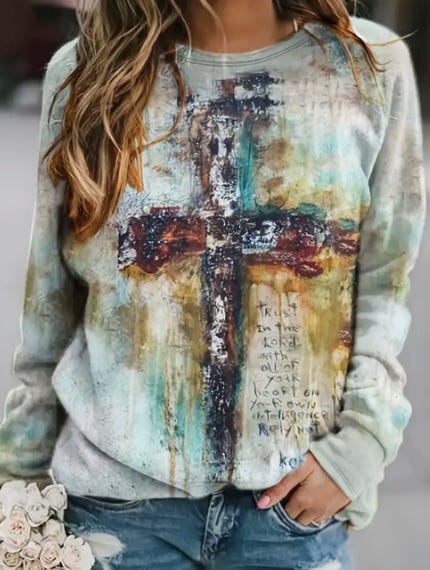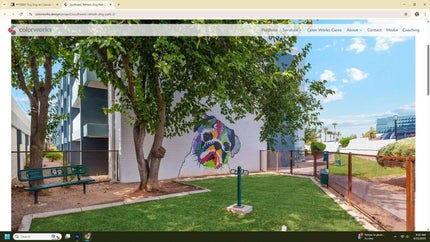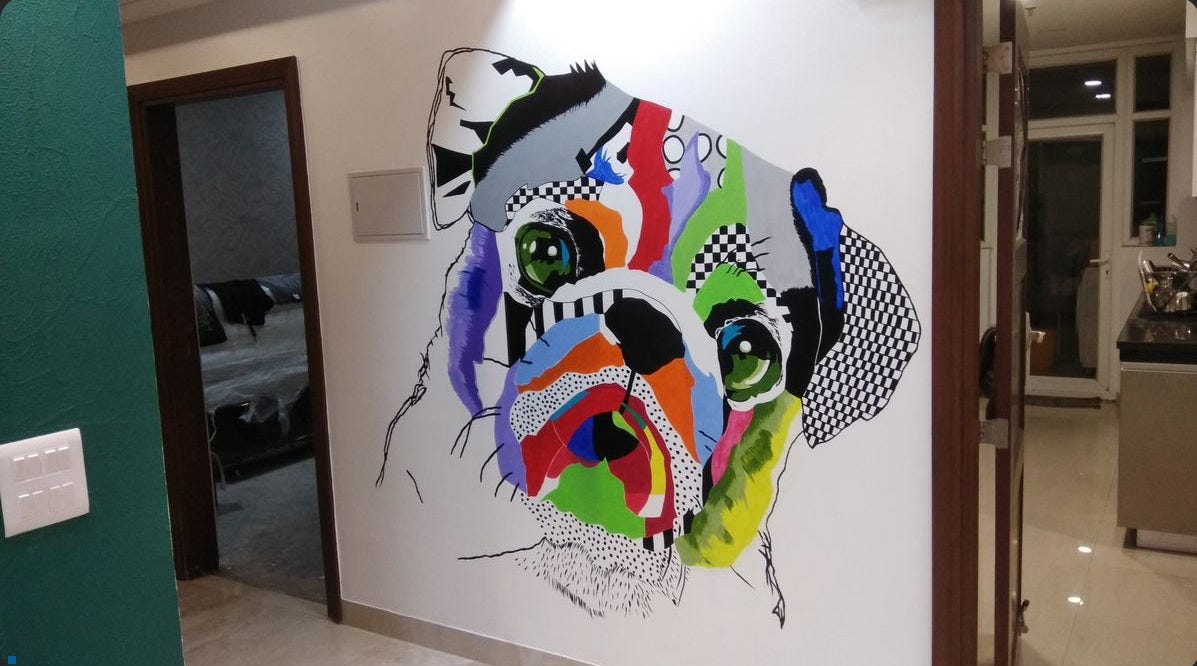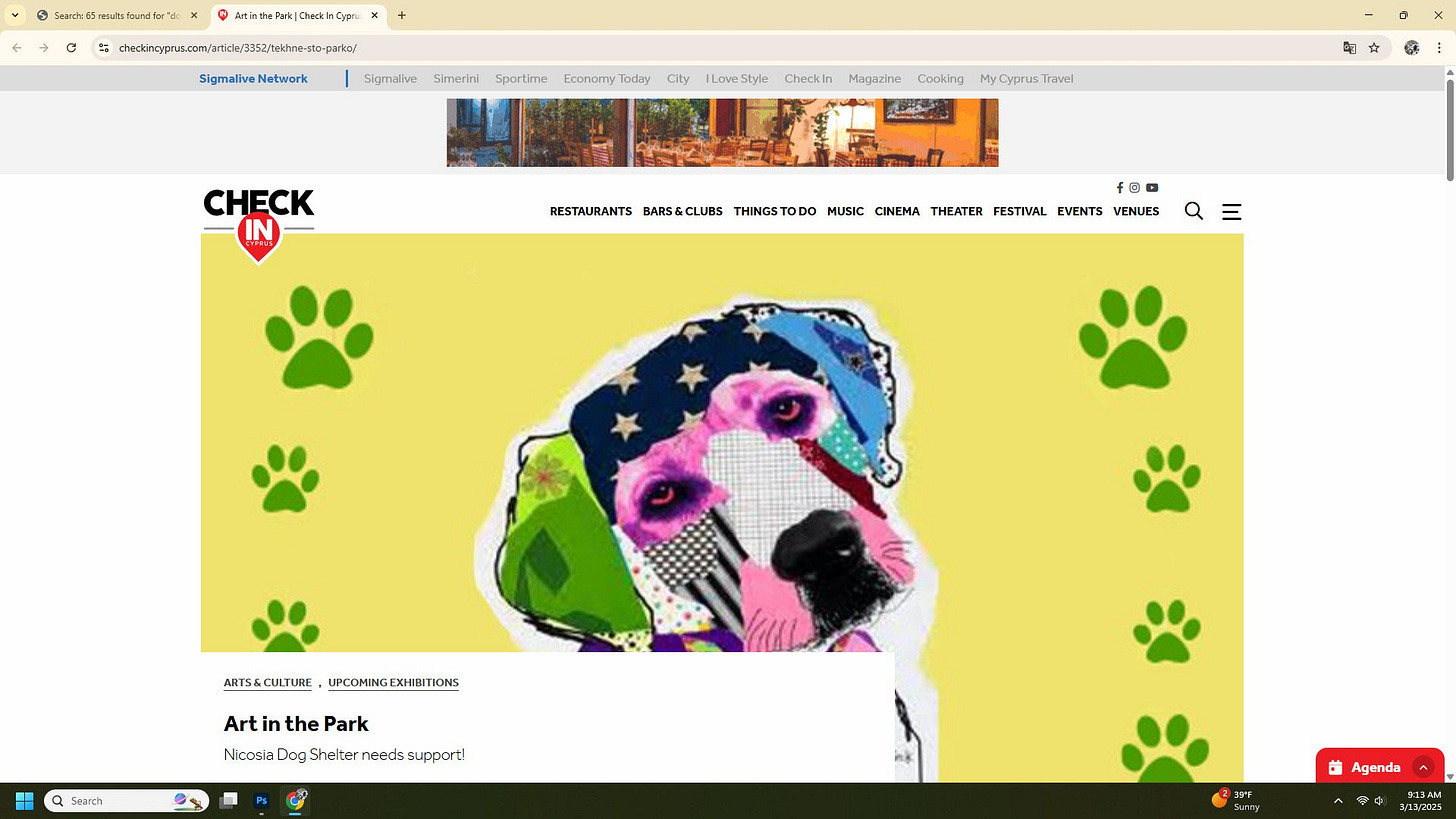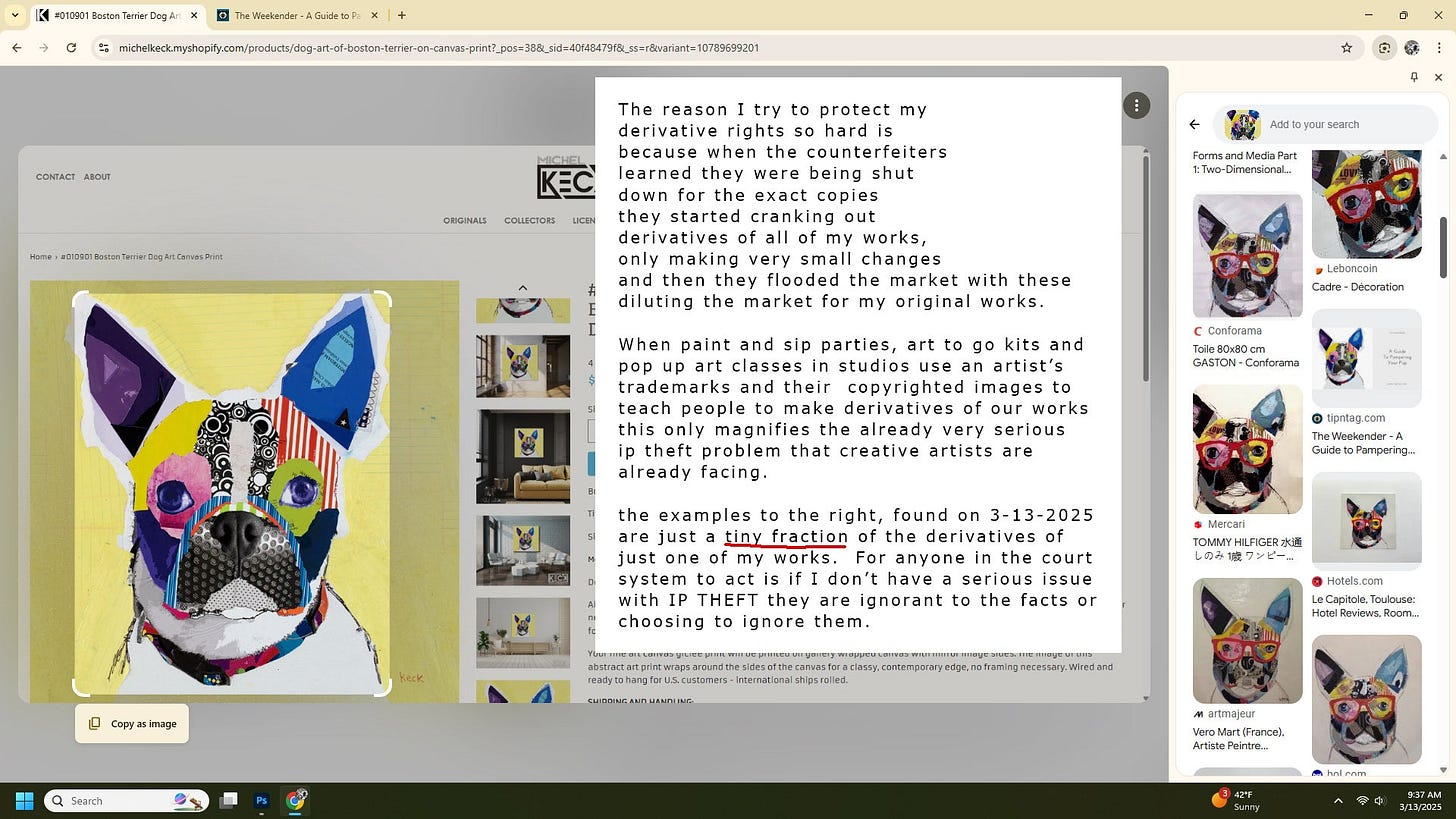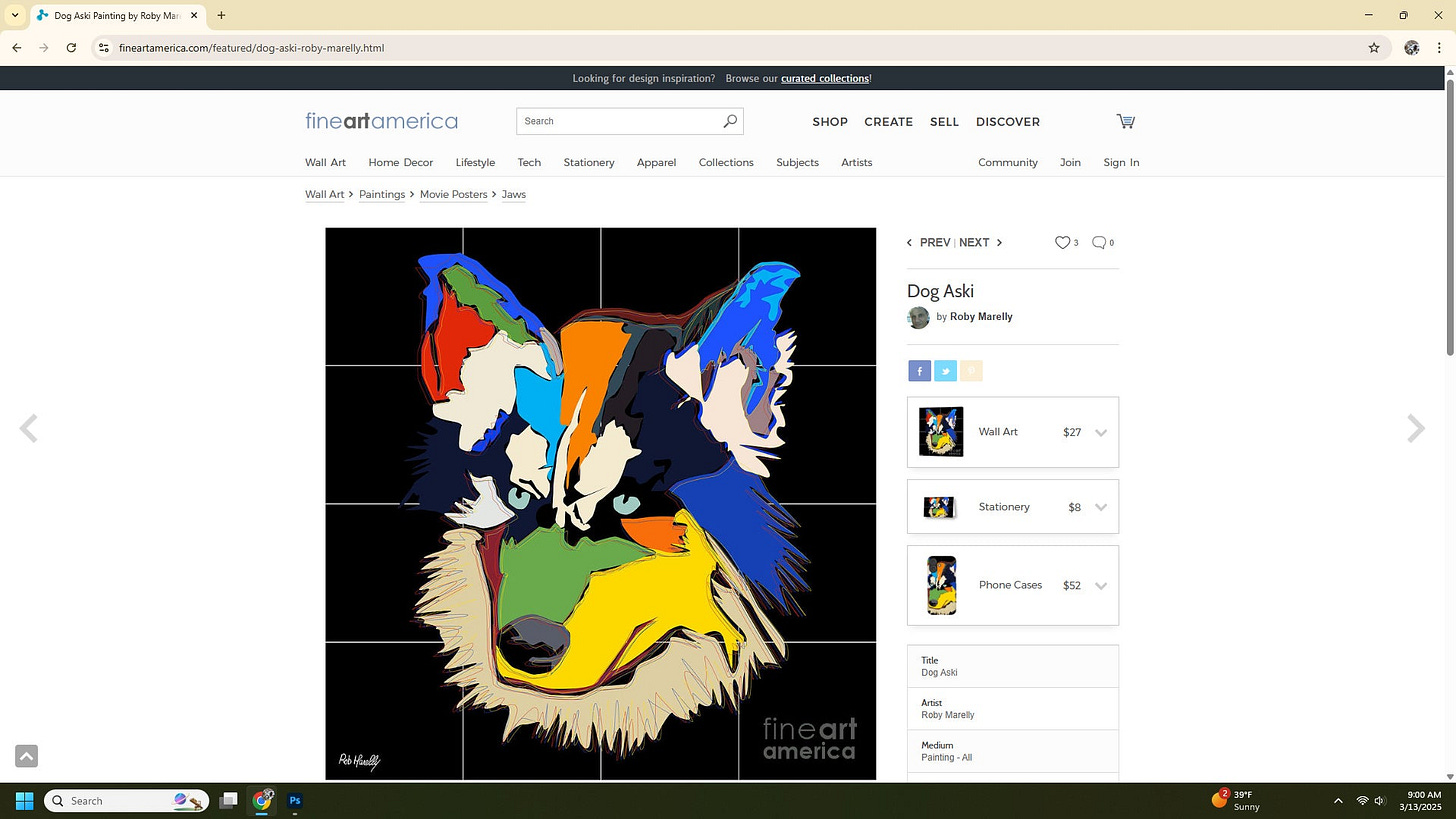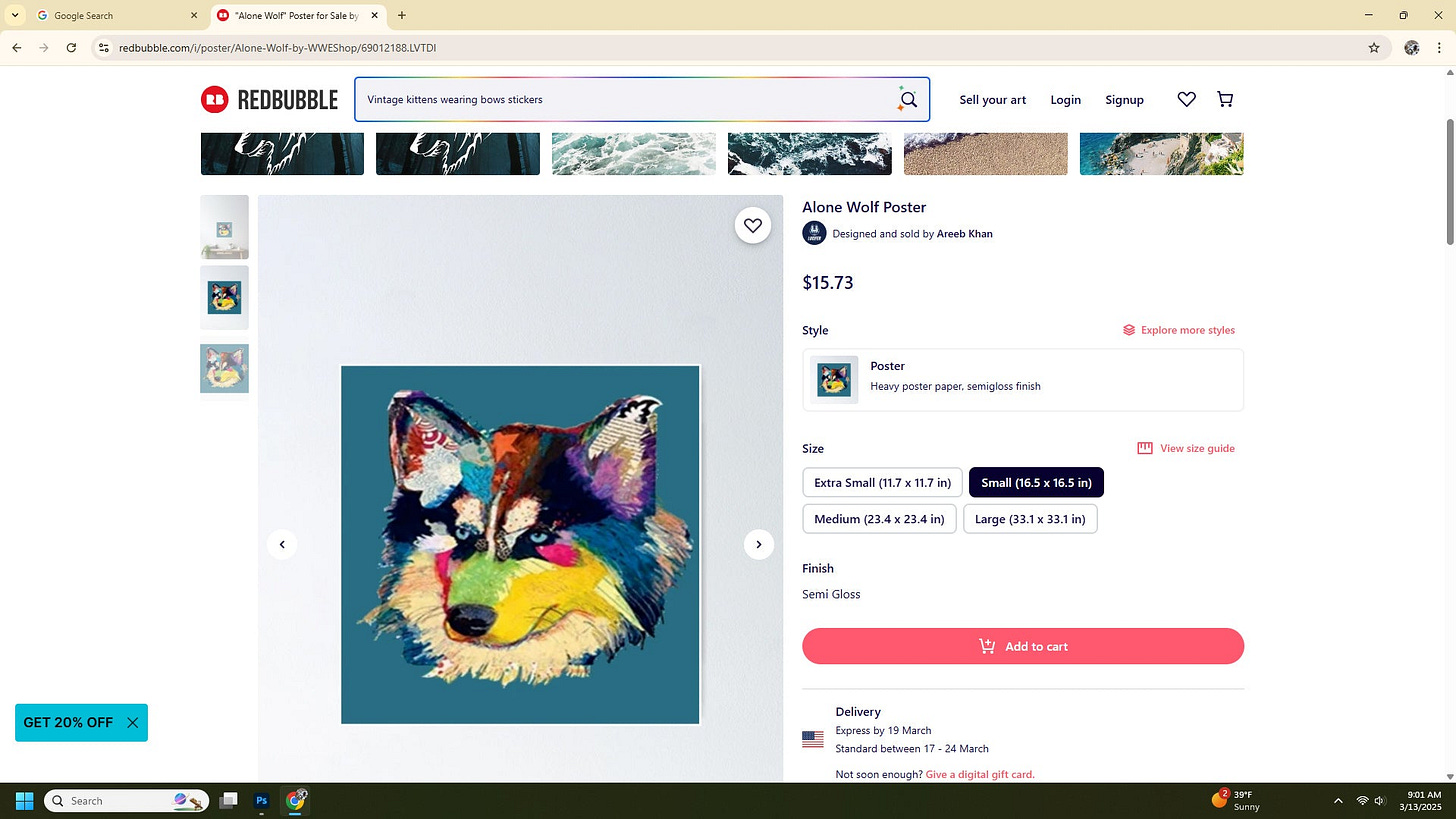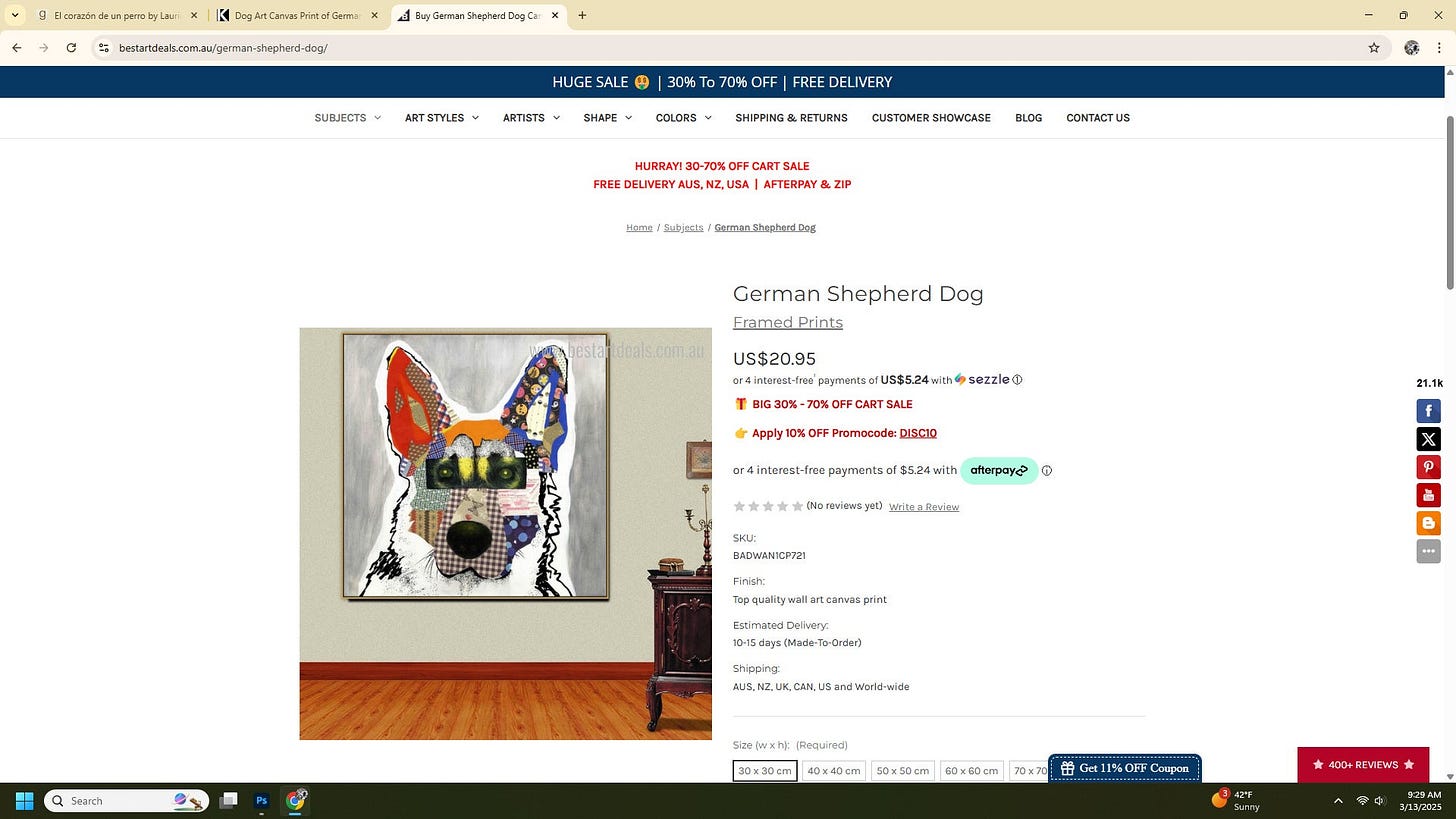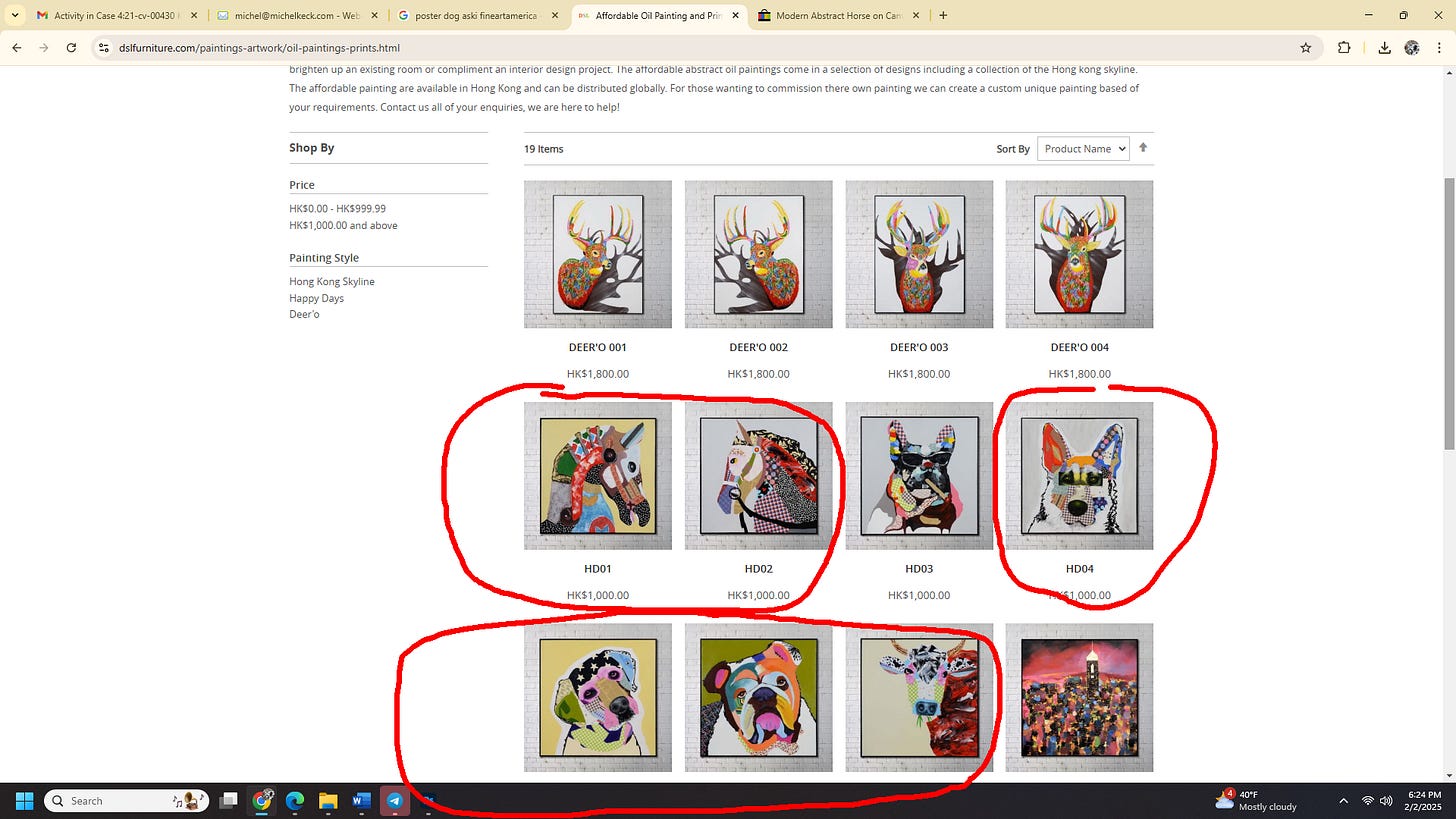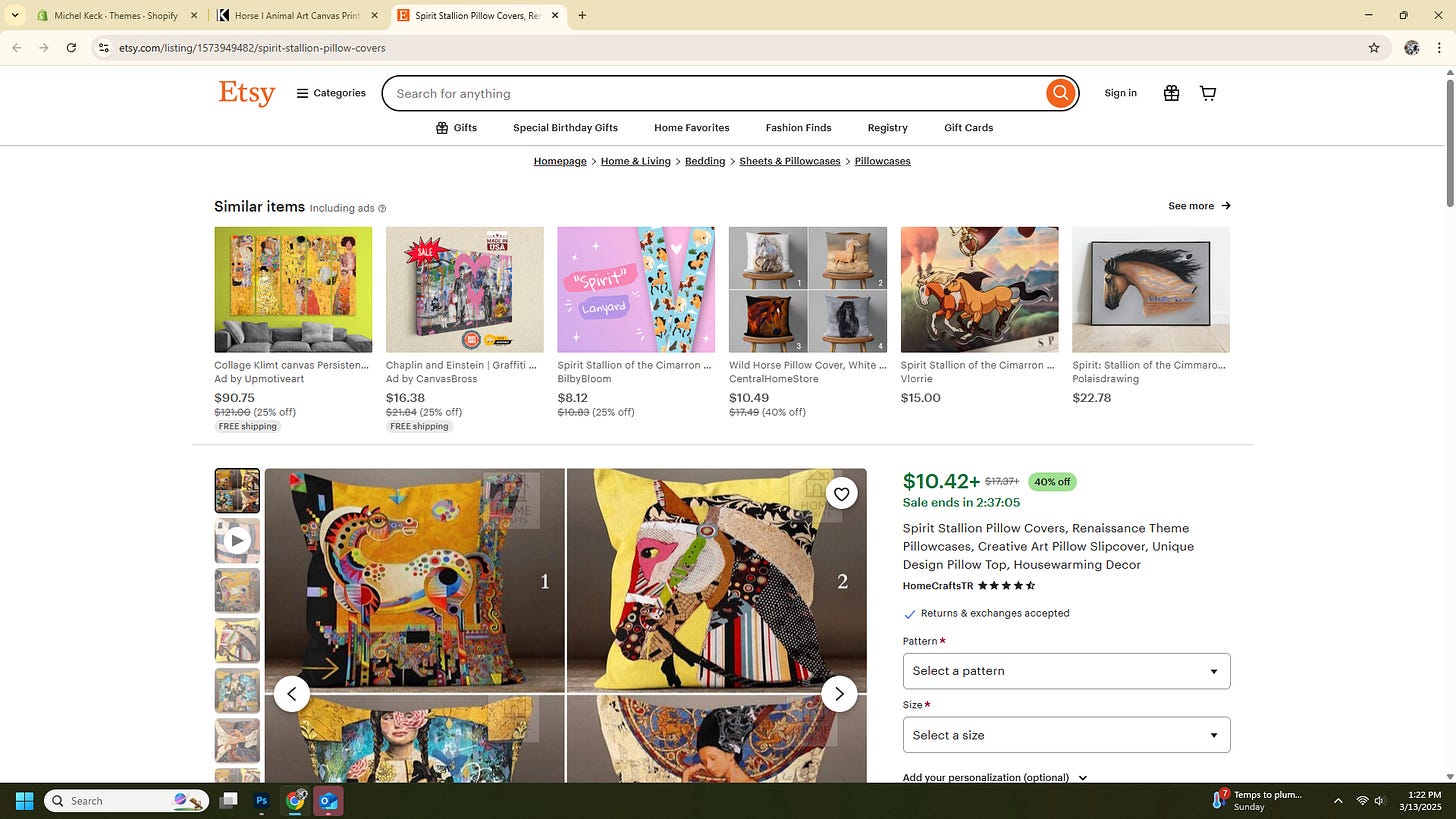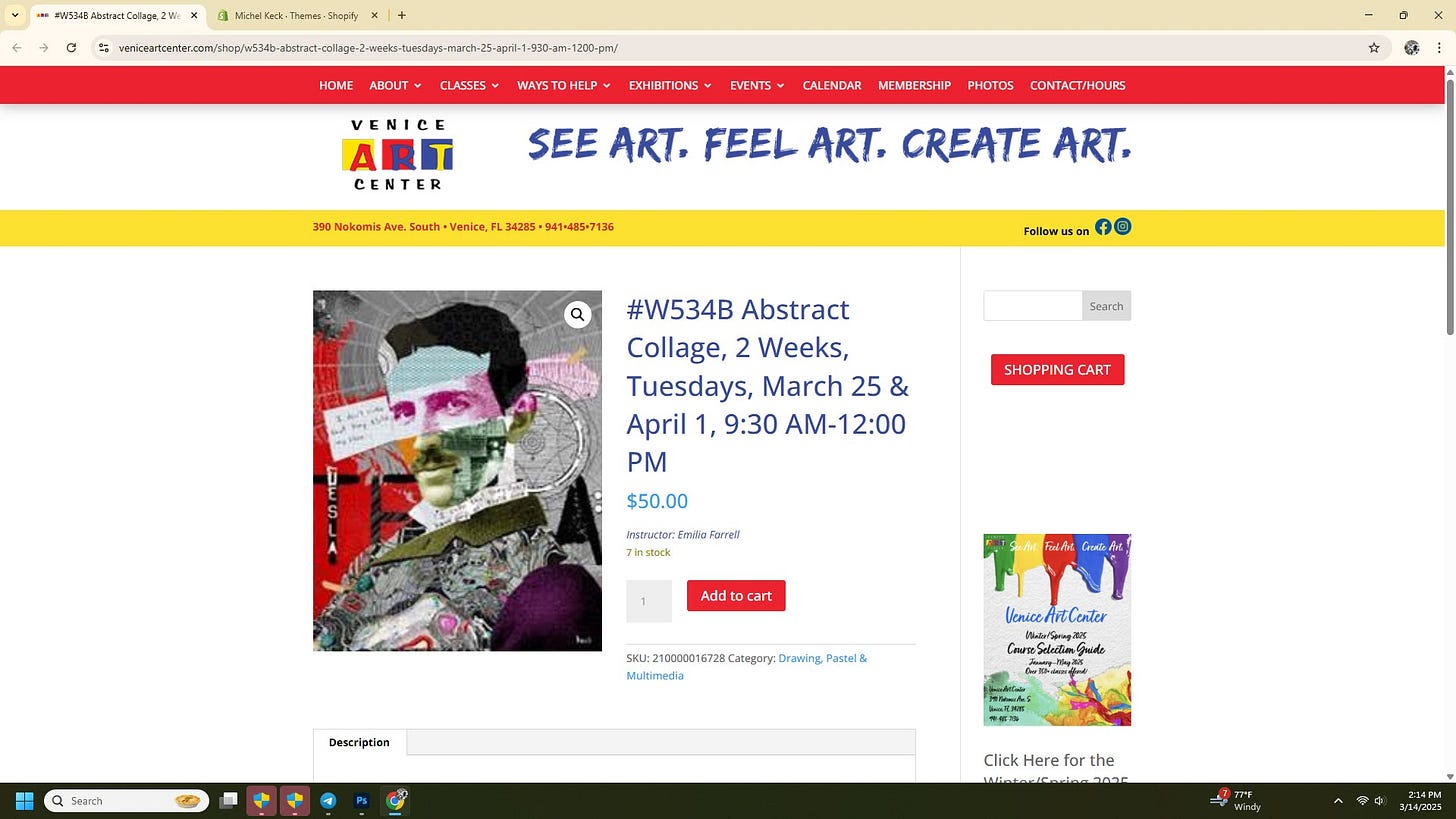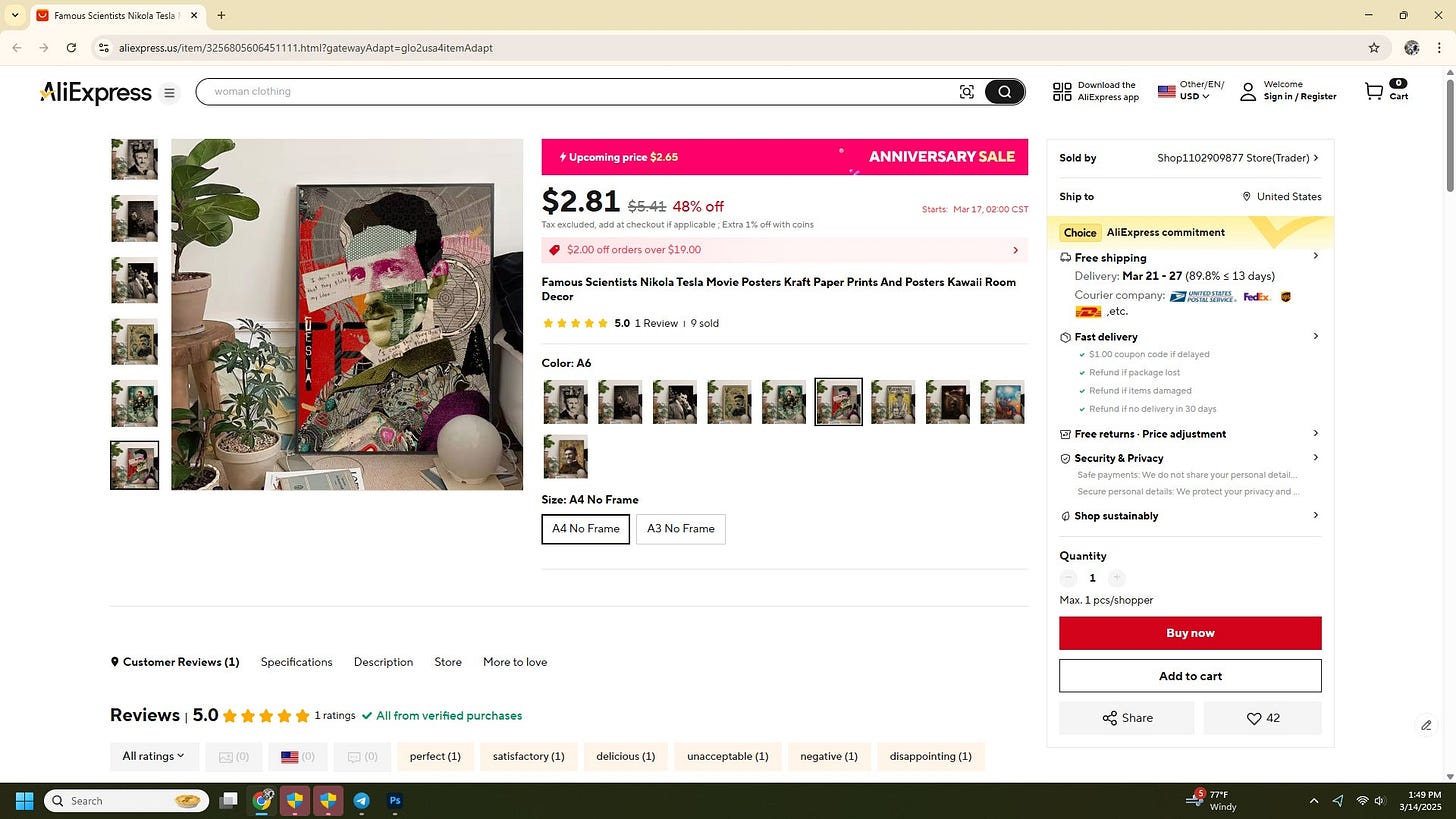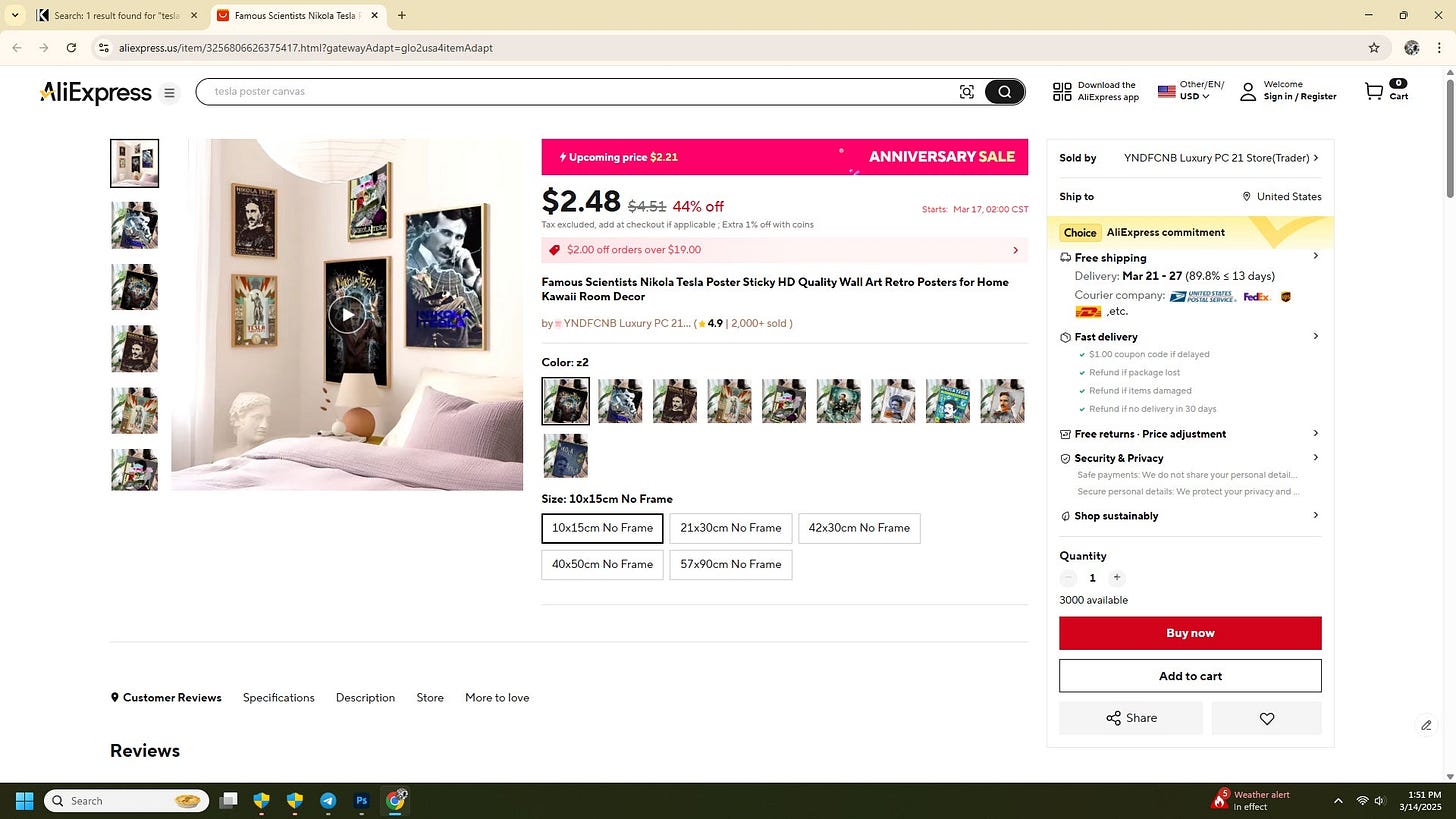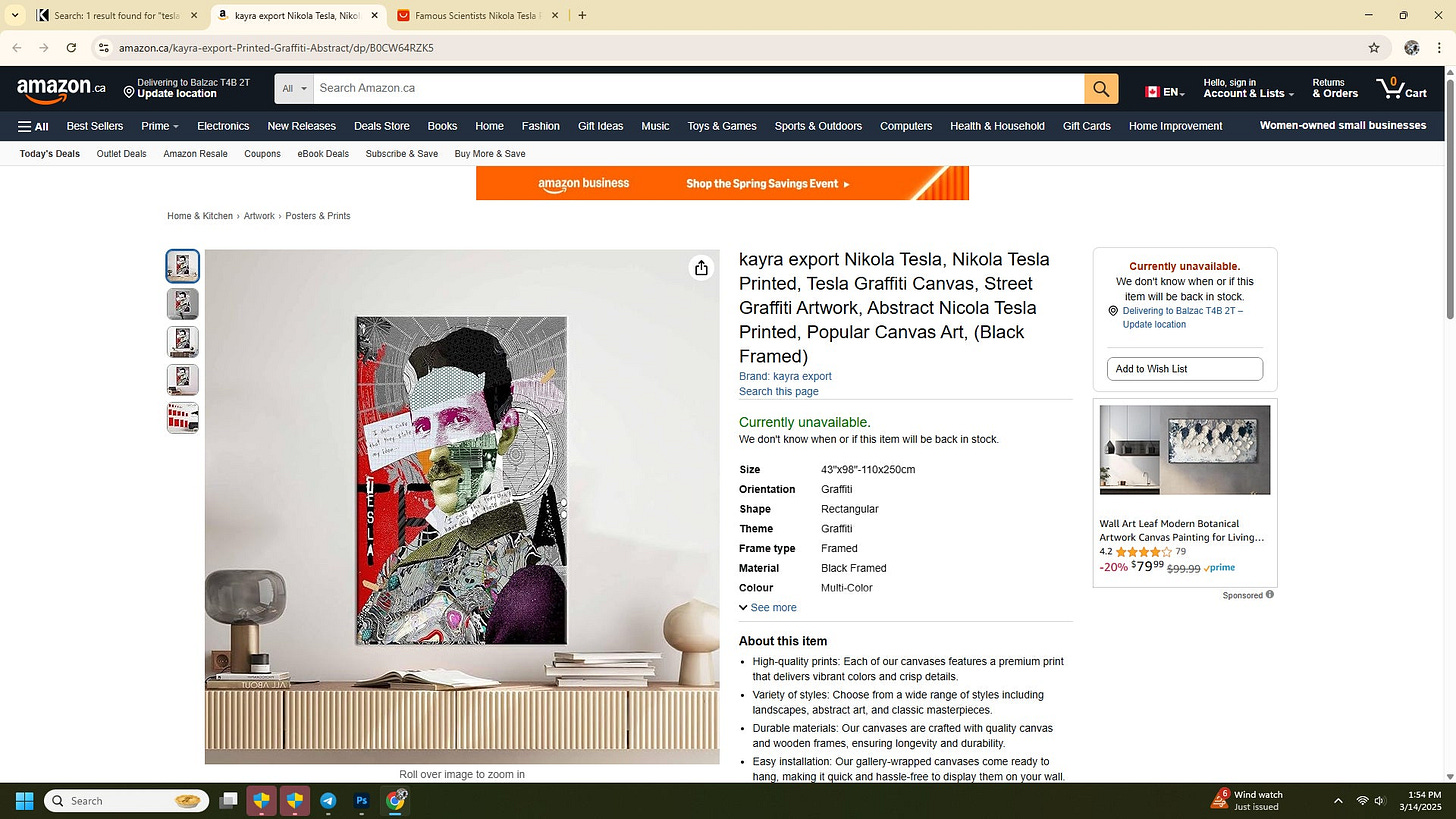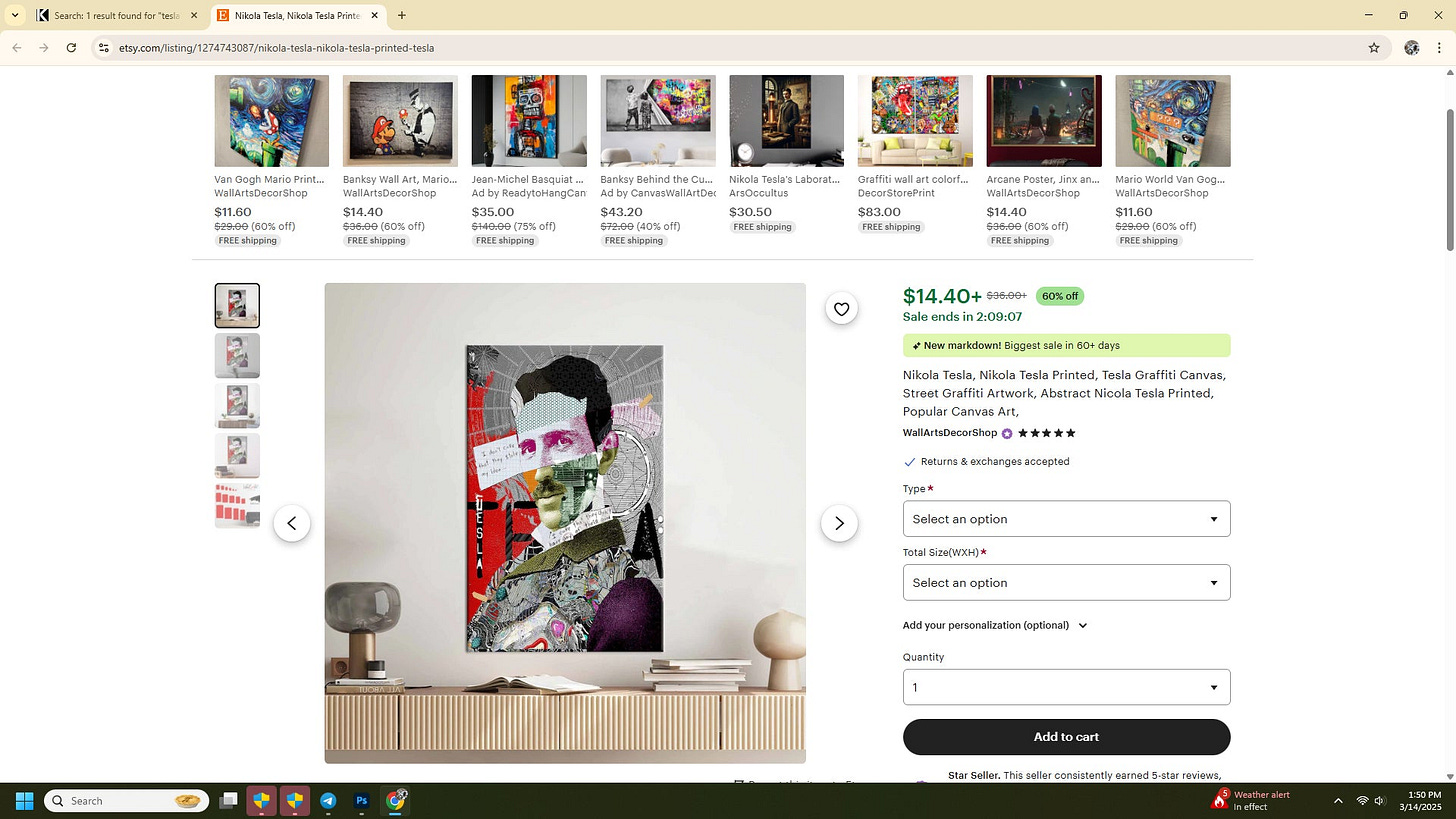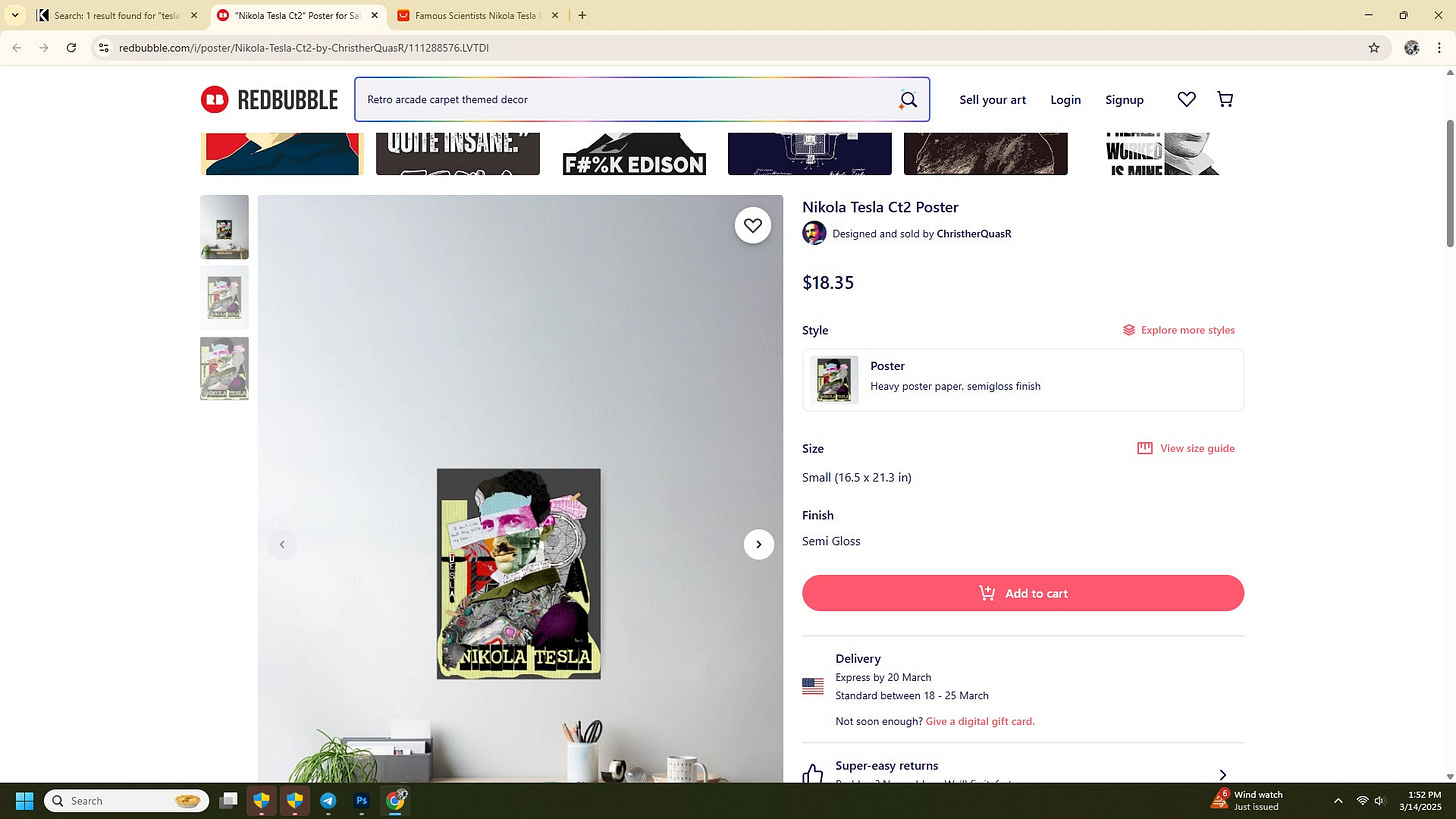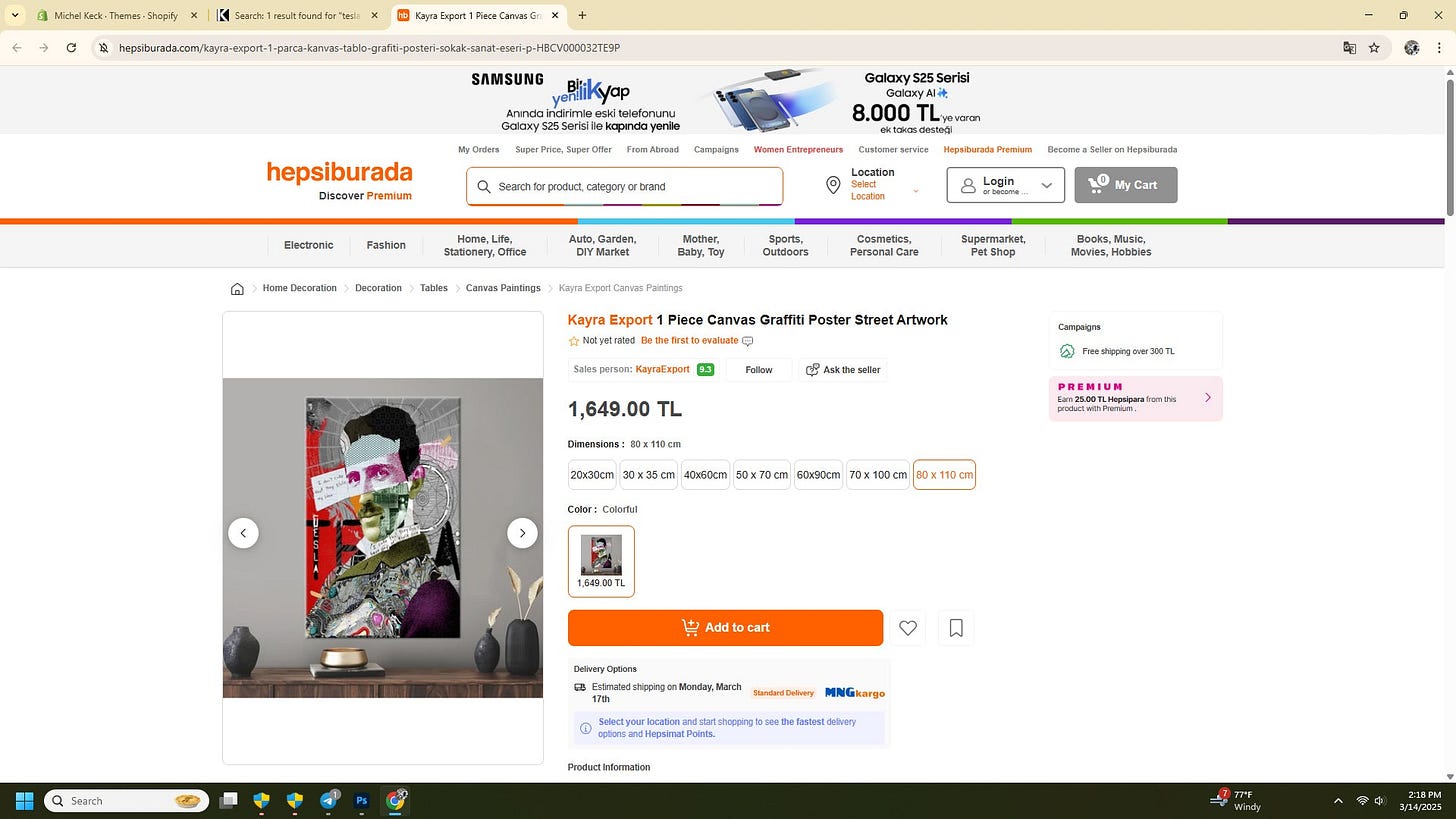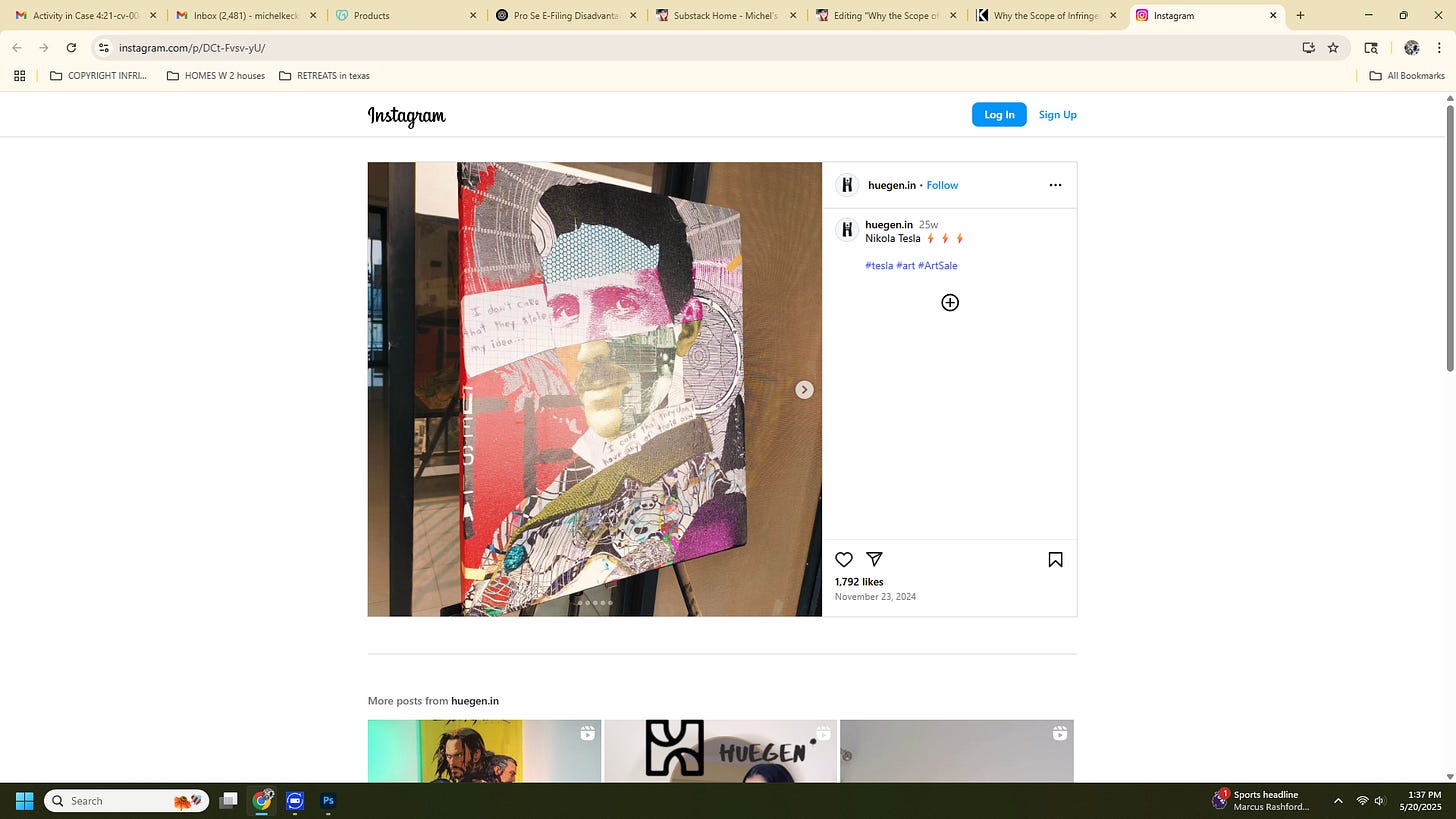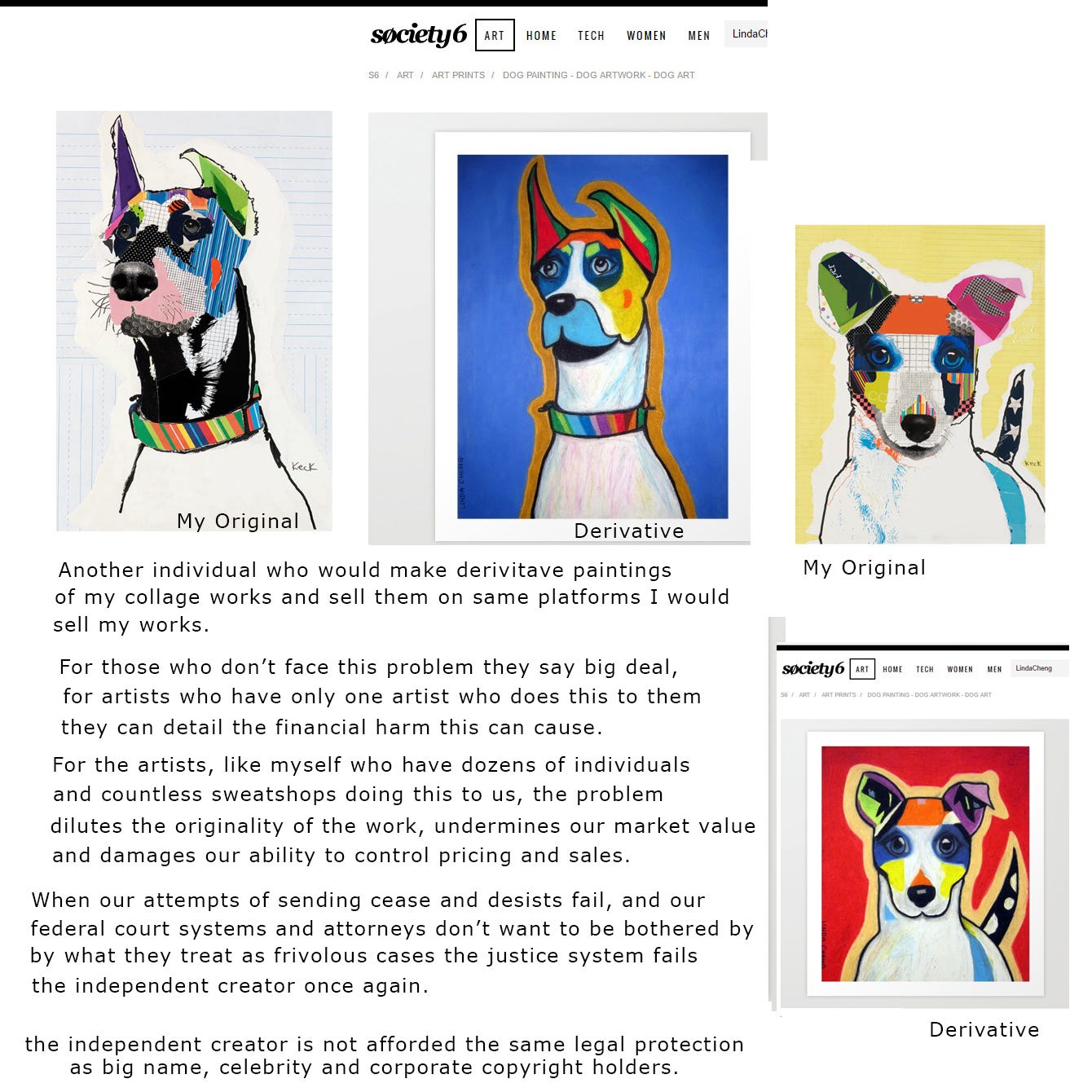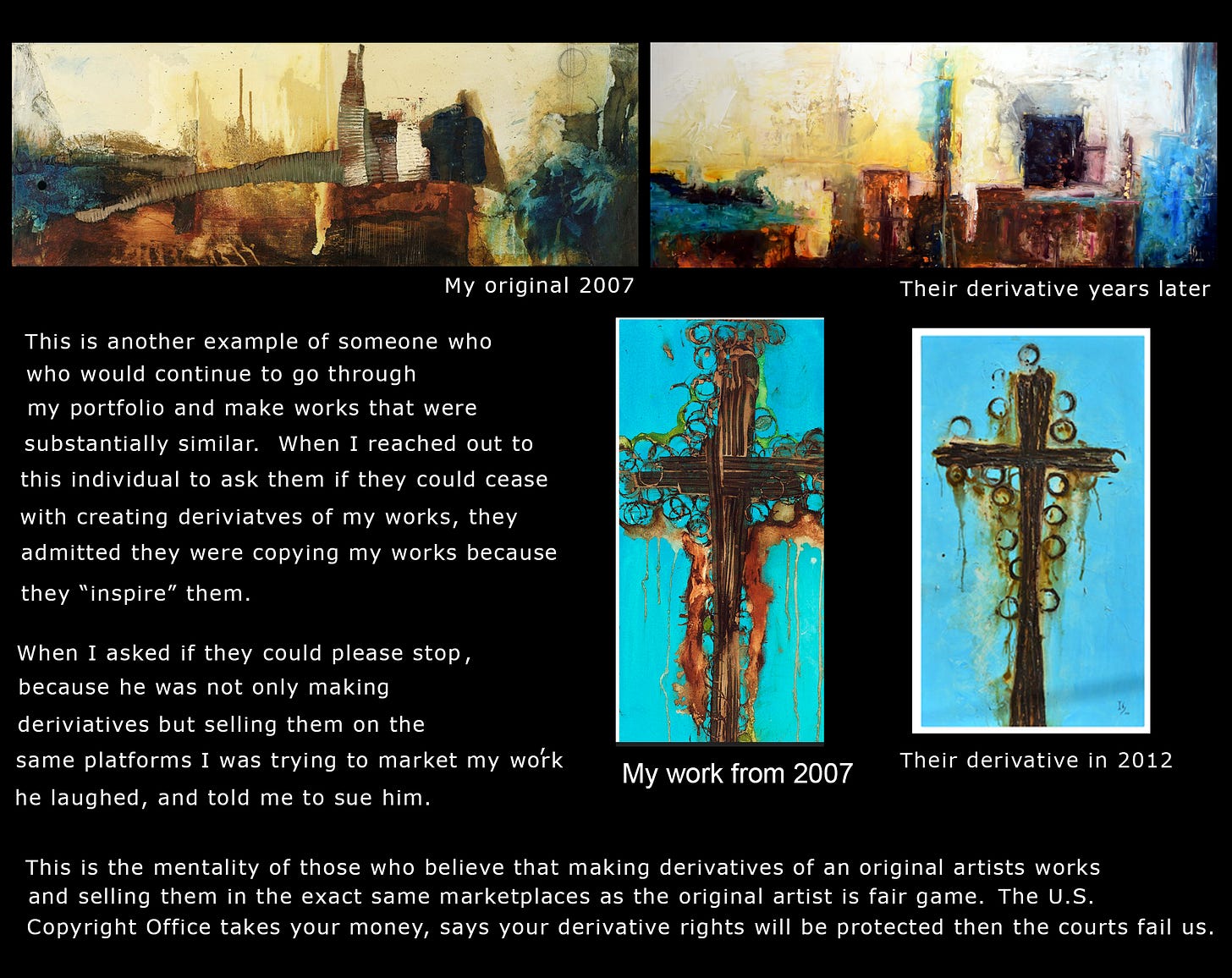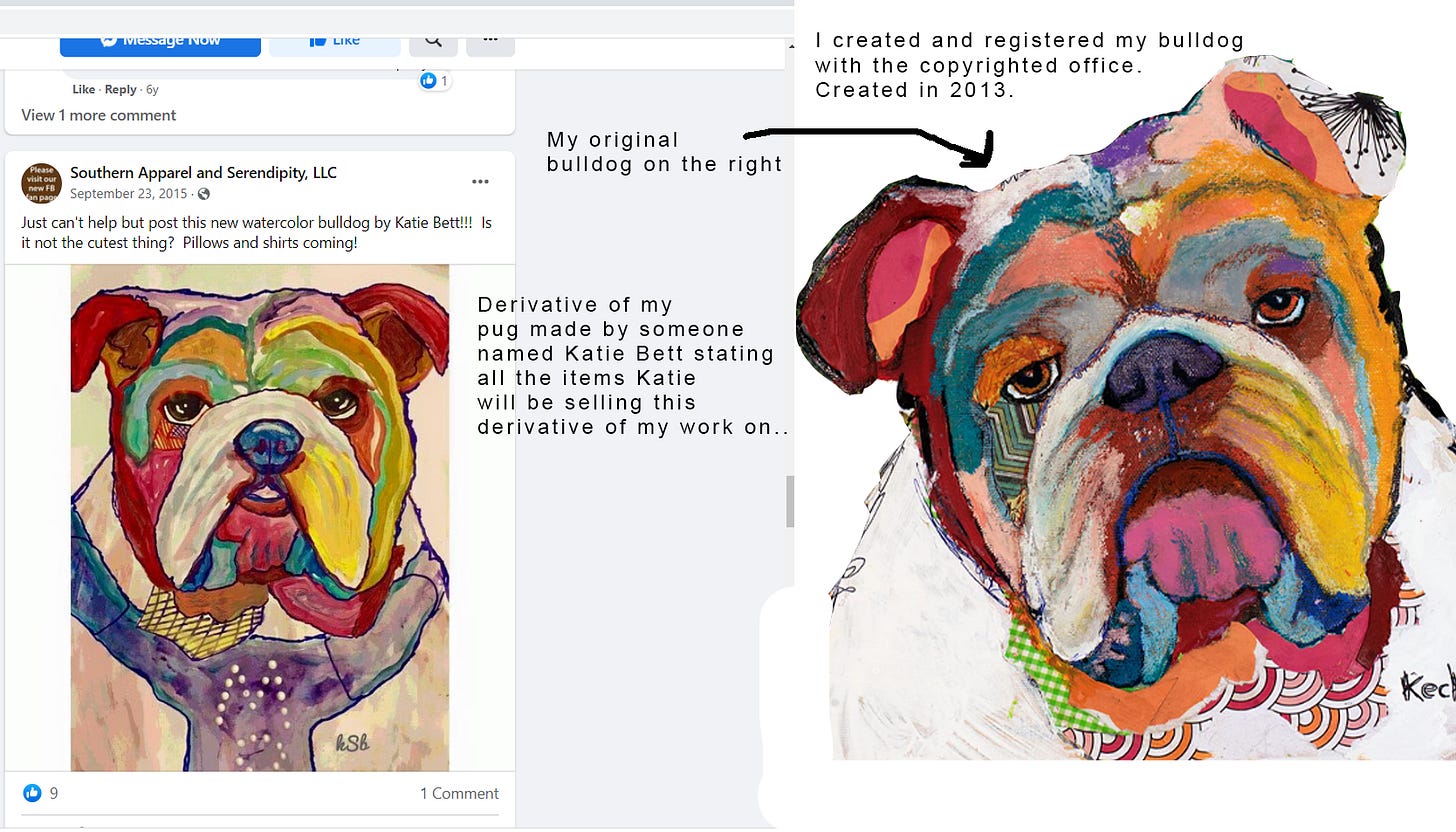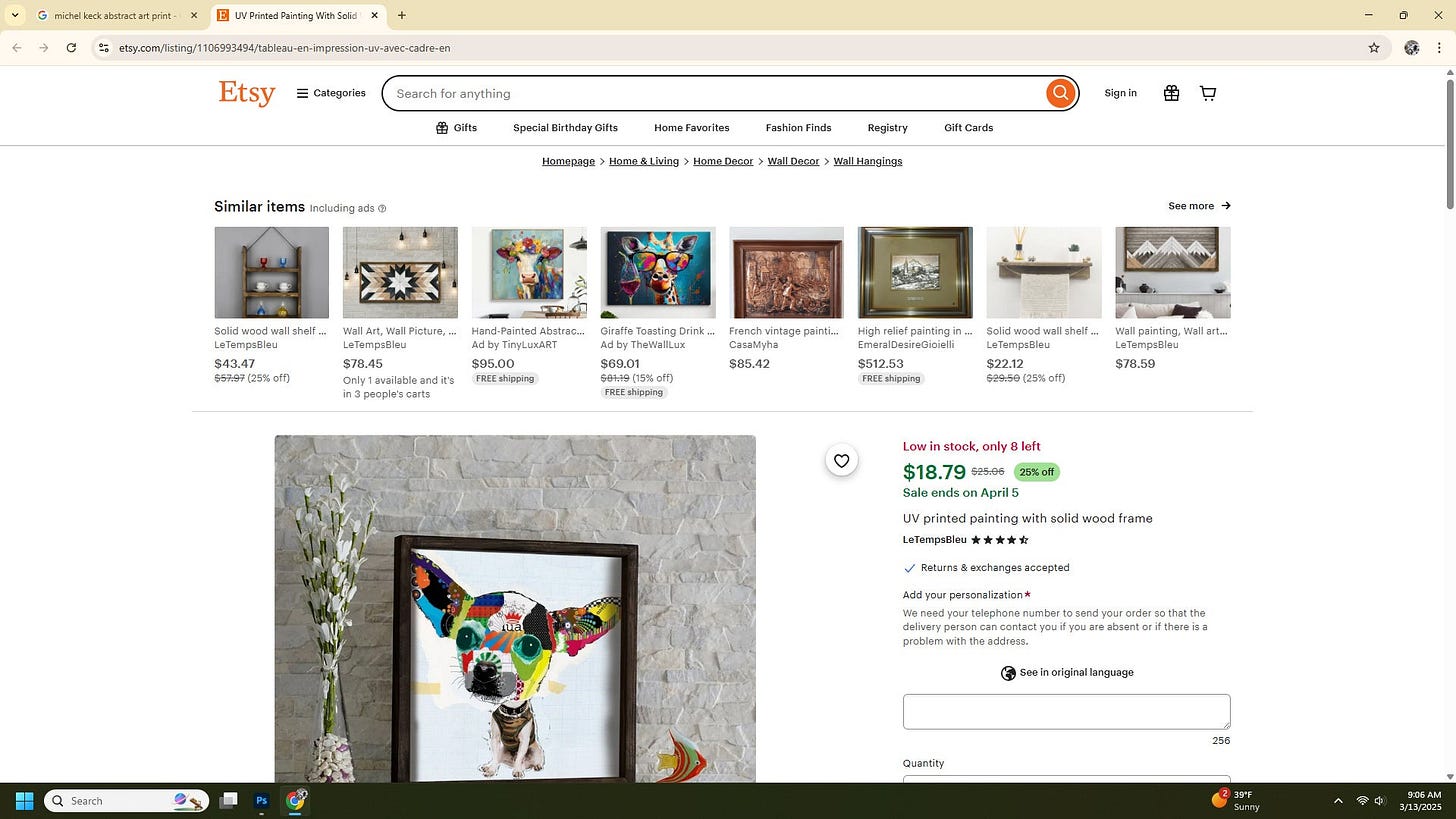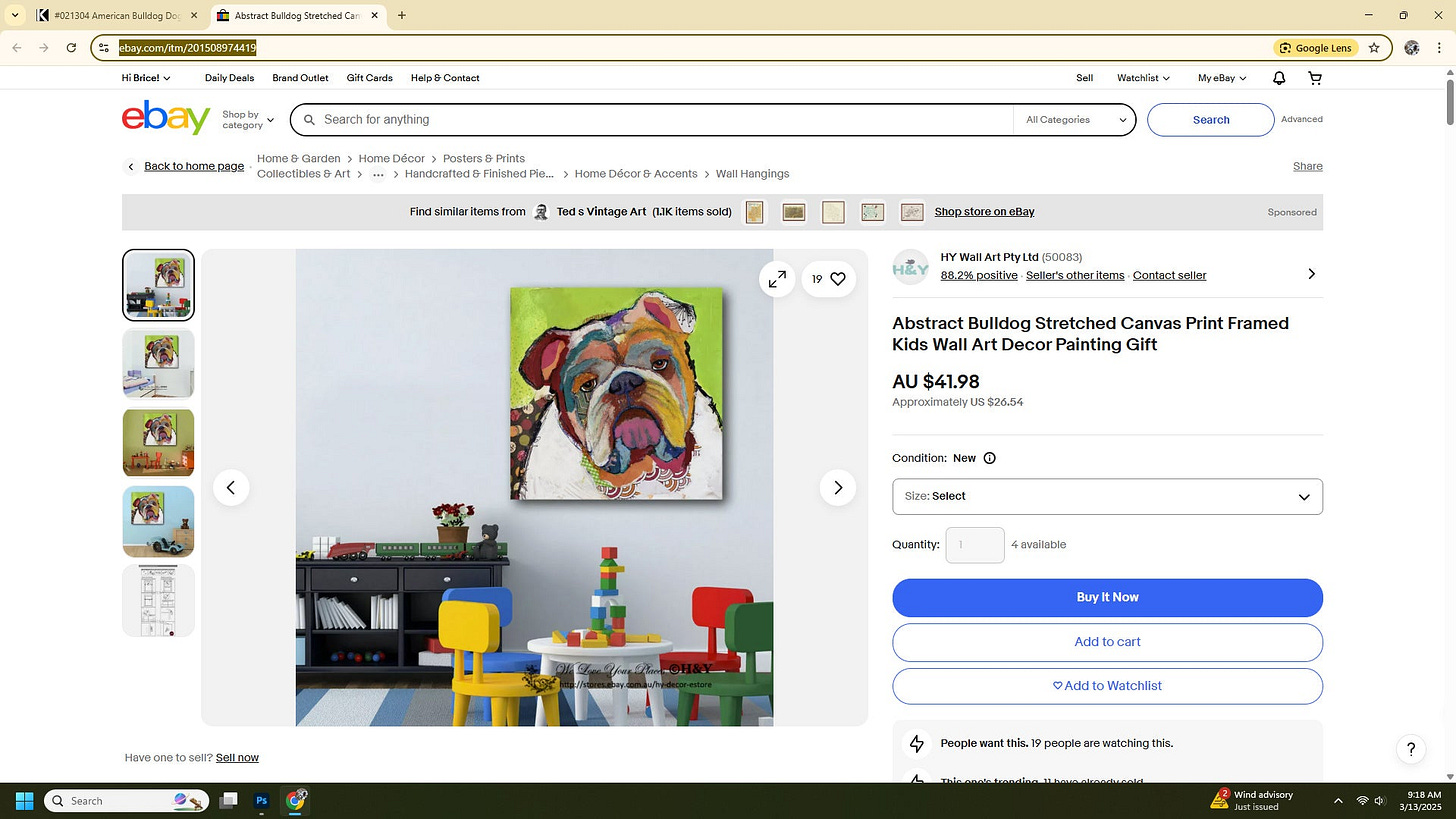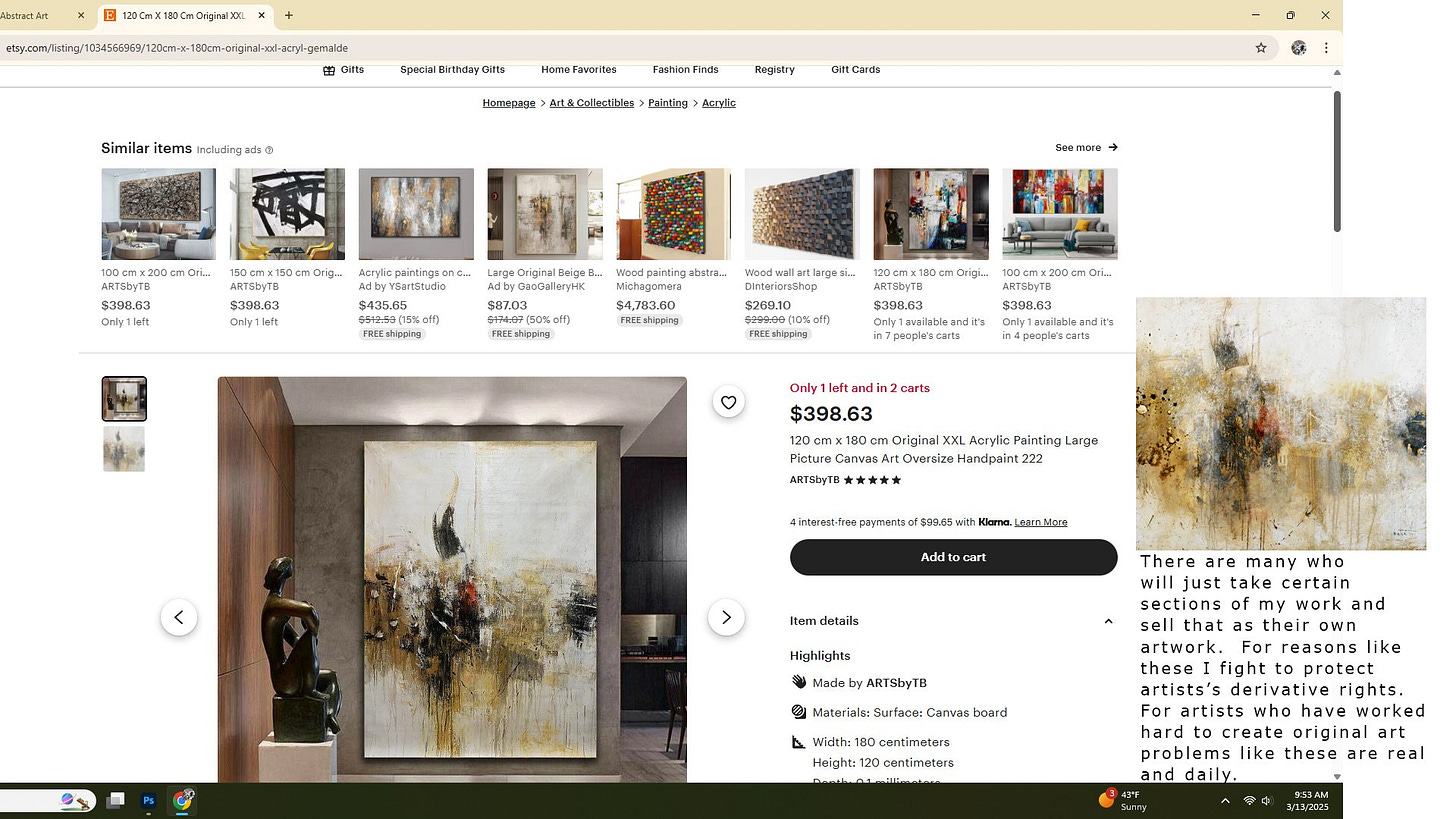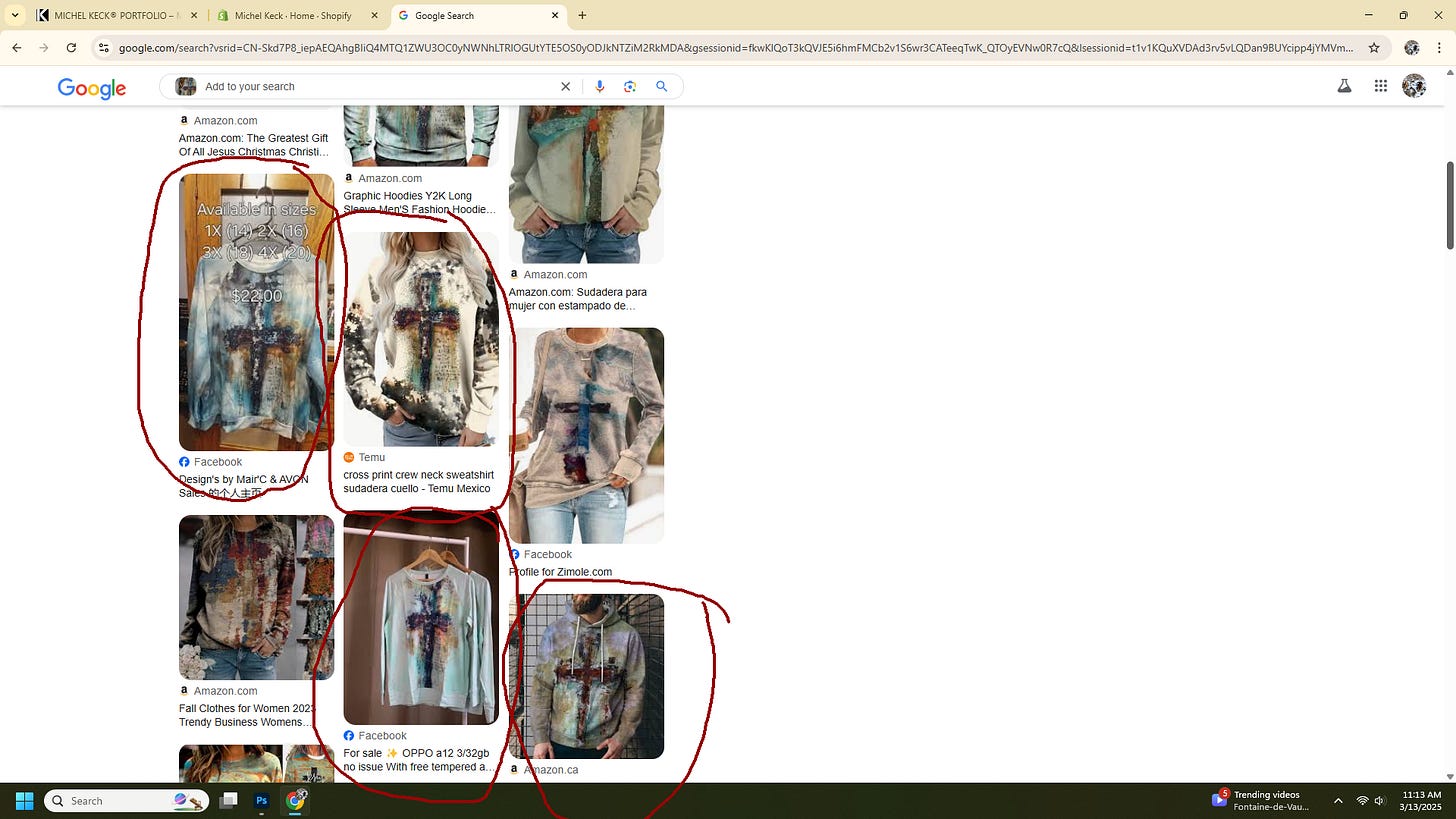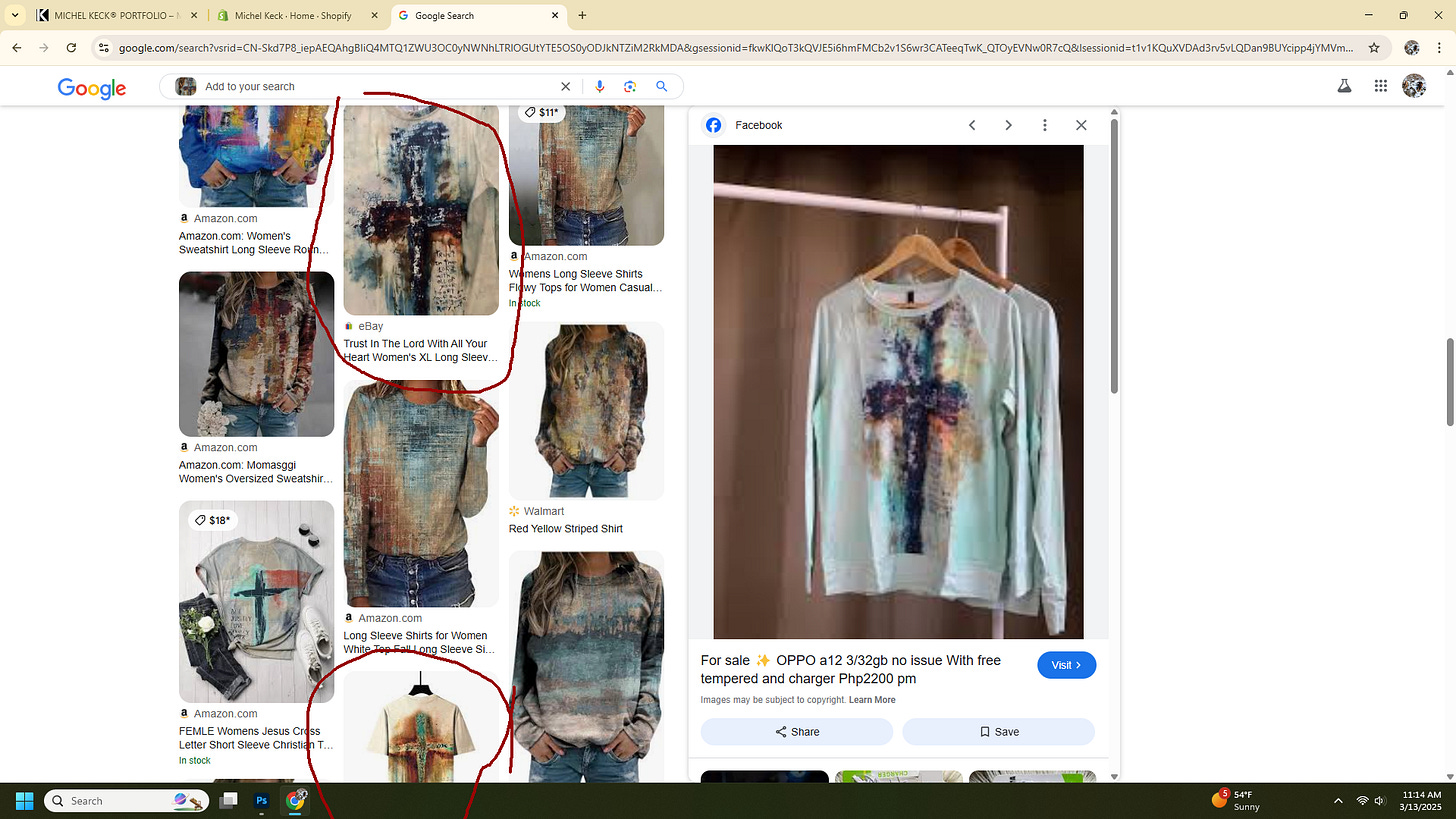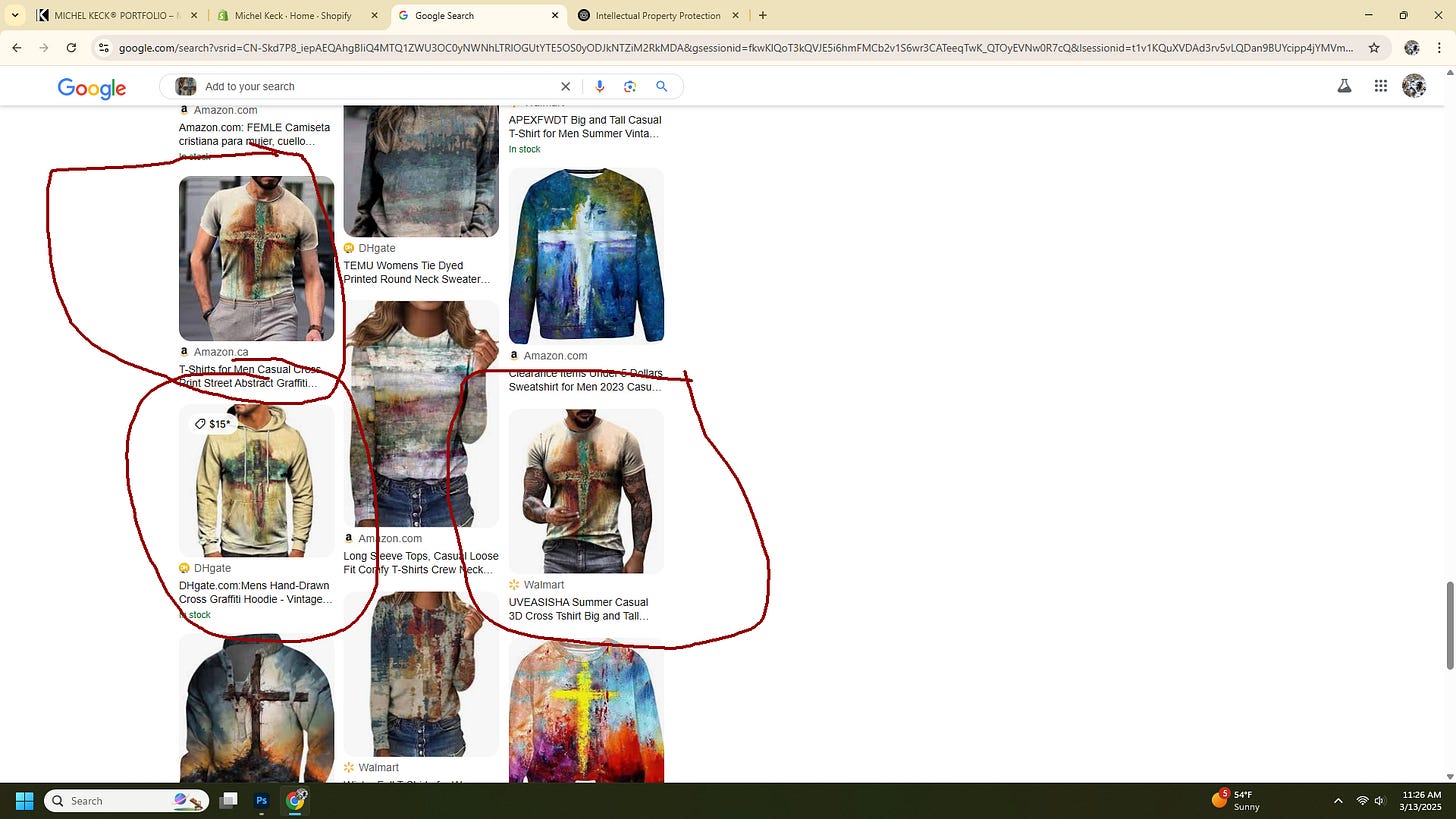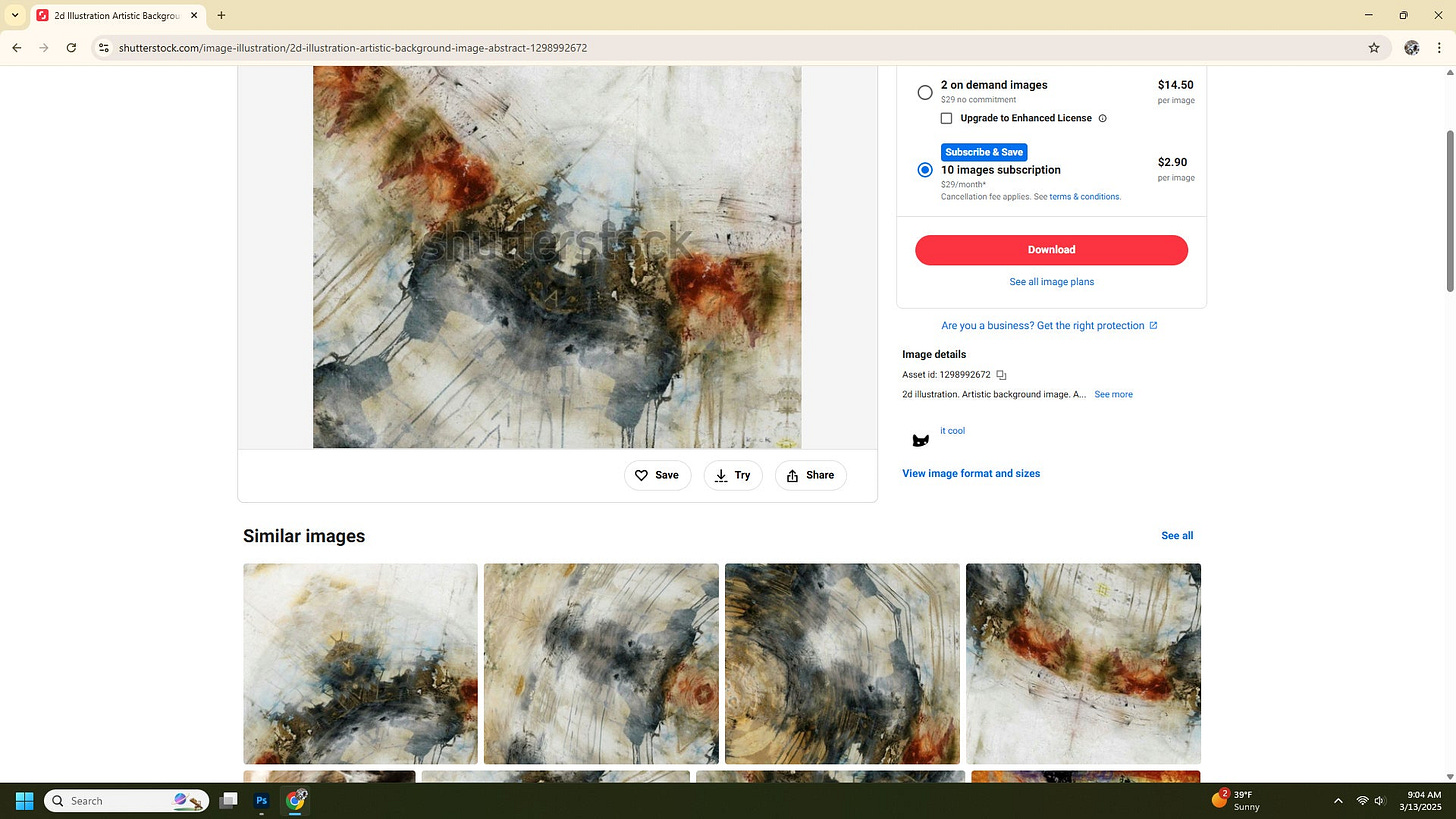
Independent Creators Are Facing Global-Scale IP Violations — And the Legal System Is Not Designed to Protect Us
If you come across any of my cross paintings or scripture-based artwork on apparel—whether on a website, in a store, or printed on any article of clothing—please understand: they are 100% unauthorized and counterfeit.
Years ago, I poured my heart into creating an all-over print scripture t-shirt line. It was a dream realized—an extension of my faith, my art, and my voice. I was so proud to bring it to life. But that pride was short-lived.
The counterfeit market for my artwork on clothing grew so large, so quickly, that I was forced to stop selling my own designs. The infringers flooded the internet with cheap reproductions—sold at prices I could never compete with—and the value of my original work was crushed beneath the weight of unlawful mass production.
So please, if you ever come across a Keck cross or scripture design printed on t-shirts, sweatshirts, hoodies, leggings, or any clothing item, know this: it was not made or authorized by me, and I do not receive a single penny from those sales. Not one.
As an artist, it is heartbreaking beyond words to see my most personal and spiritual works reduced to stolen images and bootleg merchandise. What was created with intention and integrity has been turned into something I can no longer even claim in the marketplace.
I say this with a heavy heart—not in anger, but in sorrow. Because what’s been taken isn’t just a design. It’s a part of me.
And this is just a tiny fraction of the copyright and trademark infringement I face. This blog post will offer more insight into what it’s like to have your work stolen, to lose a business you spent over two decades building—simply because we have a legal system that no longer believes independent creators deserve access to justice in federal court. That space, it seems, has been reserved for celebrities and corporations.
The following copyright infringement examples were discovered in just a few hours while searching for violations involving only a handful of my registered images. I share this not to elicit sympathy but to underscore a critical point: the scale of infringement matters — and when it comes to independent creators, the courts don’t seem to care.
Despite the immense burden creators face when defending their work, we are still expected to meet the same procedural and evidentiary thresholds as billion-dollar corporations — except without the benefit of dedicated legal teams or the resources to police theft around the globe. We rely entirely on the legal system to uphold our rights. And far too often, the legal system fails us.
When Evidence Is Ignored
During a recent appeal in a copyright and trademark case — one in which my trademark was tossed out without my consent — my husband and I were asked to compile a list of active infringements. We did so under the impression that this would be presented in court as evidence of the real-world consequences of the IP violations I endure. Shockingly, this evidence was never submitted in either the original case or on appeal.
What’s more, nearly all of the URLs of infringing materials that we gave to our attorneys were mysteriously removed by the infringers — without a DMCA notice or cease and desist from us — something that in my more than two decades of business has never happened. The courts never saw that either.
A Day in the Life: Just One Afternoon of Infringements
Yesterday afternoon, I conducted a limited search and found dozens of new violations. Below are only a few examples:
-
A mural of my pug design painted without permission in what appears to be a dog park. I was informed by the designers that the mural was already present when they acquired the building.
-
Another unauthorized mural of the same design on a business wall in India.
-
My images used in promotional advertising for events and products — without a license, and without compensation.
-
Mass-produced derivatives of my animal collage works, altered just enough (adding sunglasses, changing colors) to masquerade as original art, yet undeniably derivative of mine. These are sold in chain stores worldwide.
-
Unauthorized derivatives of my Husky and German Shepherd designs found on Redbubble, Fine Art America, and in Chinese mass-manufactured products.
The following example showing just one site selling multiple derivatives of my original collage works. (You can see how substantially similar they are to my originals by viewing my original images at www.michelkeck.com)
-
My horse collage used on pillows and posters, with sellers inviting customers to “contact them” — monetizing my work without my involvement.
-
My art showing up in paint-and-sip classes, art kits, and pop-up workshops, where my trademark is used to sell the event without my knowledge or approval.
Every one of these is intellectual property theft. And every one of them affects the value of my business and the market for my work.
In just a few moments time, by doing a search for just one of my images, like my original Tesla collage above, I can find multiple infringements of just one work.
For me it is not just a problem I have with unscrupulous sellers infringement my copyrights and trademarks in the United States but in numerous countries.
The following, like many counterfeits, I find on social media. The one below an instagram account saying they have a Tesla art sale. Counterfeit. I will never see a dime. These counterfeits and unscrupulous sellers flood the market and devalue my work. This puts independent creators OUT of business and our legal system does not take our intellectual property rights seriously.
If you're an independent creator facing massive copyright and trademark infringement, you’re left with an impossible choice: if you don’t fight, you drown—but if you do fight, you're met by a court system that often treats your case as a nuisance. The truth is, independent artists are rarely afforded the same attention, respect, or seriousness that celebrities or corporate entities receive when they walk in to protect their intellectual property. It is systematically unfair, and it sends a clear message: our rights matter less.
Derivatives Are Not Harmless
When courts dismiss the harm of derivative works — especially those that involve only minor cosmetic changes — they ignore the dilution of the creator’s brand and market share. These versions flood marketplaces, confuse consumers, and leave the original artist uncompensated for work that is legally protected.
Fair use rulings that favor those monetizing art classes, kits, and sip parties built on unauthorized uses of original artwork only further devalue the creator’s control over their brand and reputation. Such rulings perpetuate a narrative that independent artists’ rights are not worth enforcing.
There exists a troubling class of individuals who self-identify as “artists” but build their careers by appropriating the work of successful, independent creators—producing derivative works that dilute, distort, and devalue the originals. When creators attempt to address these violations privately, outside of the legal system, they are often met with harassment, ridicule, and threats. In my own experience, infringers have brazenly mocked me and told me to “just sue”—a response I’ve encountered more times than I can count.
But when we do turn to the courts, seeking protection under the very laws meant to safeguard our rights, we are routinely dismissed. Judges and clerks minimize the harm with statements like, “They only sold a few,” or “They said they’ll stop.” The underlying message is unmistakable: the rights of independent creators are not worth the court’s time.
This is why the scope of infringement must be taken seriously. This is not a minor annoyance—it is a death by a thousand cuts. I have personally witnessed independent artists lose their entire livelihoods not because the law failed them, but because the legal system refused to hold infringers accountable.
There is no meaningful deterrent. There is no structural accountability. And until there is, intellectual property theft against independent creators will continue unchecked—silently erasing the very people who built their art from nothing, and whose only crime is creating something worth stealing.
If This Were Disney...
If Disney were to find even a single derivative mural, an unauthorized plush toy, or an art kit mimicking their characters, the legal system would leap to enforce their rights. Courts would never question the scope or validity of Disney’s claims, nor would they suggest that enforcing them is a waste of time.
But when independent artists like myself walk into court — sometimes without lawyers, sometimes with attorneys who fail to advocate effectively — we are met with indifference or disbelief. The scope of infringement we face is treated as anecdotal, not systemic, and our rights are often dismissed as if they’re worth less.
The Evidence Is Here — The Problem Is Real
Below are only a few examples of the derivative and infringing works discovered yesterday alone:
-
Derivatives of my Tesla collage found across various global marketplaces as shown above.
-
Unauthorized prints of my Chihuahua collage being sold on Etsy.
-
Unauthorized prints of my Bulldog collage being sold on eBay.
-
Cropped, squashed, and recolored versions of my "Die Trying" artwork sold on Etsy without any authorization.
-
My abstract cross designs appearing on apparel sold through U.S. and international e-commerce sites.
-
Multiple versions of my work being licensed by third parties on stock platforms like Shutterstock — without my permission or compensation.
The breadth and frequency of these infringements demonstrate not only the value and impact of my original work, but the global scope of its unauthorized exploitation.
And yet, none of this was presented to the courts on my behalf — despite being collected, documented, and handed over to my attorneys. Keep in mind this was all found in just a short time in one afternoon.
When the Legal System Looks Away
To be clear: I am not copied because I’m unsuccessful. I am copied because I have created something that resonates. No one steals what isn’t valuable.
And when courts minimize or ignore the reality of IP theft against independent creators, they make a dangerous choice: they tell the marketplace that it’s safe to exploit small artists — because the courts won’t stop them.
We are not asking for special treatment. We are asking for equal enforcement of the law — for our copyrights and trademarks to be taken as seriously as the IP of any Fortune 500 company.
This Is Bigger Than Me
For many of us, this is not just business. It is personal. Our work is our identity, our livelihood. When someone strips our name off it and sells it under theirs, we’re being erased.
The U.S. must not go the way of countries where IP law is little more than a formality. The foundation of copyright and trademark protection — and artistic integrity — is crumbling when creators must spend more time proving their right to protect their work than actually creating.
This is not just my problem. This is the future facing every independent creator.
Final Thoughts
I’m done trying to prove to the courts that what is happening is real. The evidence is overwhelming and undeniable. It should have been taken seriously, and it wasn’t.
One must ask: Did the presiding judge in my original case ever see what I, as a small business owner and working artist, am truly up against? The answer is a resounding no. My counsel failed to present the scope and severity of the intellectual property infringements I face on a near-daily basis. And what of the appellate court? Did the appellate judges ever receive a full, accurate picture of the relentless onslaught of infringements that threaten my livelihood, my brand, and my ability to survive as an independent creator? Again—no. Despite repeated assurances from both Higbee & Associates and The Digital Justice Foundation that the breadth and depth of these violations would be clearly laid before the court to underscore the seriousness of my claims, this evidence—to my knowledge—was never submitted.
This is not a procedural misstep. This is a gross failure of representation and advocacy. It is indefensible that courts tasked with ruling on the fate of my intellectual property rights were not shown the very evidence that would demonstrate the life-altering reality of what I endure as an independent artist. Unlike billion-dollar corporations with in-house legal departments and global enforcement arms, I have no such resources. I am my own brand. I am my own legal advocate. And each infringement chips away not just at my revenue—but at my name, my reputation, and my ability to keep a roof over my head and food on my table.
When courts and counsel fail to take seriously the rights of independent creators—when they dismiss our federally registered copyrights and trademarks as secondary or insignificant—it is not just a legal injustice. It is the quiet, sanctioned erasure of our ability to survive in a marketplace increasingly hostile to the originators of content. Judges who ignore this reality are not neutral arbiters—they are, whether knowingly or not, complicit in the slow destruction of small creative businesses across this country. If our rights are not afforded the same weight as those of large corporations like Disney®, then we no longer have a system of equal protection—we have a legal hierarchy that serves power, not principle.
Let the record reflect: we do not ask for special treatment—we demand equal protection under the law. And that begins with the truth being seen, heard, and entered into the record.

